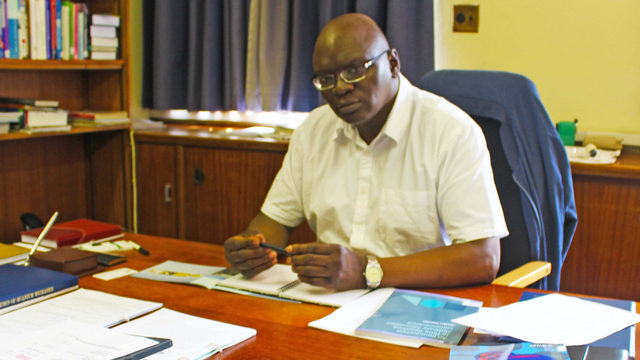
By Julian A Jacobs, PhD candidate, School of Journalism and Media Studies
Professor Makaiko Chithambo, Head of the Physics and Electronics Department of Rhodes University published a book entitled An Introduction to Time-Resolved Optically Stimulated Luminescence late last year.
“This book is about solids. It is about the study of imperfections or defects in solids which are able to attract and trap electrons,” said Prof Chithambo. “Luminescence itself is the light that is emitted from a material that has absorbed radiation and if the material is stimulated it emits light.”
“Radiation,” he continued, “Is a source of energy and when you expose a solid to radiation, that energy releases some electrons from atoms. Some of the electrons can end up at certain kinds of imperfections and get trapped. Now when you expose the material to certain types of light, that external light provides energy to those electrons and then they become free electrons. These electrons have excess energy so they are unstable and they lose the excess energy in the form of light and this light is called luminescence.”
Prof Chithambo has been interested in studying luminescence using time-resolved methods since the days of his doctoral studies. He joined Rhodes University in 2002. He recalls when he first started on this project. “I was isolated; on my own. My topic of interest was not attractive to others, but I saw the potential of this project and I kept at it. I did not follow what the rest of my fellow researchers worldwide studied, I followed my own path. I want to encourage my students to adopt that same attitude by being tenacious in your pursuit to fulfil your dreams.”
During his doctoral studies and beyond, Prof Chithambo developed theories around this time-resolved luminescence and created and constructed instrumentation that did not exist in the market. In doing so, he ensured that certain applications of his work could have an impact on society. One method is called ‘dating’, which works out the age of materials by looking at the amount of charges trapped inside. Another application is thermal provenance by which one determines which temperatures rocks or minerals were exposed to during formation. Another application is called radiation dosimetry, which uses materials in their natural or synthetic form as dosimeters to measures the amount of radiation levels that, say, medical personnel taking x-rays of patients are exposed to. Prof Chithambo’s work is focused on investigating the physics of imperfections using time-resolved techniques rather than the applications.
Very recently, Prof Chithambo received confirmation that he has been published once again, this time for contributing a chapter to a book entitled: Advances in Physics and Applications of Optically and Thermally Stimulated Luminescence.
An Introduction to Time-Resolved Optically Stimulated Luminescence is available through the publishers Morgan & Claypool, via Amazon and in Grahamstown through Van Schaik Books. The online ISBN is 978-1-64327-198-9 and print ISBN is 978-1-64327-195-8.
